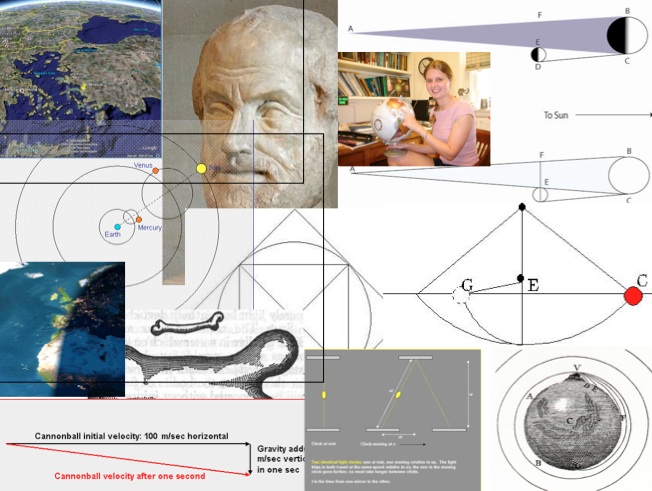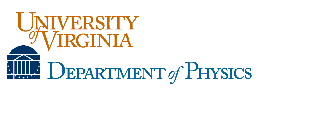|
|
HomeDr. Richard A. Lindgren, Research Professor of Physics Department of Physics, University of Virginia Professor Lindgren is very experienced in teaching online courses and has taught over a thousand students over the past 10 years. For information about the Instructor, click here Office Phone: 434-982-2691 E-mail: ral5q@virginia.edu LECTURER AND DEMONSTRATOR ON VIDEO: Dr. Michael Fowler, Maxine S. and Jesse W. Beams Professor of Physics DESCRIPTION: The course explores two revolutions in our perception of the universe. The first, in which Galileo played the leading role, was the realization that what we see the moon, the planets, the sun and stars are physical objects. For example, the moon has a rocky surface, not unlike some parts of earth, and is not made of some exotic ethereal substance, as had been generally believed before Galileo. This discovery led to the realization that the motions of the moon and planets obeyed the same physical laws as ordinary things moving on earth. Newton put this all together to give the first unified picture of the universe. The second revolution was that Einstein realized that this was not the whole truth. Space and time are not as straightforward as they first appear, but are related to each other in a simple but unexpected way. Among other results, this leads to the surprising consequence that mass and energy are different aspects of the same thing. The course will follow the development of ideas approximately in the historical sequence. It will begin by reviewing some of the Greek contributions to math and science, which were essential to both Galileo and Einstein in their work. We shall study the Pythagorem theorem, and a few other ideas about triangles. We shall also look at Greek ideas about the solar system, and how they measured the distance to the moon quite accurately (using the ideas about triangles). We will examine how these ideas reached western Europe by way of the Arab world. You will see some experiments on the video which led to understanding motions of projectiles, and show how Newton connected these results with the motion of the Moon, and thereby all the planets. We shall then go on to consider the nature of light, for this is what led Einstein to question the concepts of space and time. The last part of the course will develop the theory of special relativity, including time dilation, relativistic mass increase, and E = mc2. This is a graduate credit online physics course for study at home. The level is suitable for high school physics teachers and physical science teachers with some knowledge of mathematics mainly due to the latter part of the course on special relativity. This course can be used for re-certification, endorsement credit, and can be used in partial fulfillment of the requirements for the Masters of Arts in Physics Education degree at UVa. To view a sample lecture, click on radio button Sample Lecture Videos. The lectures are in MP4 format and can be viewed using the software Quicktime on your computer. When you get your UVa email and password, you may download any lecture from the UVa COLLAB website. COLLAB This course is organized around COLLAB, the UVa version of Sakai, which is a learning management system used by over 350 educational organizations. You will obtain access to the complete organization of this course on COLLAB after you are registered for the course. COLLAB access is password protected. All the lecture videos and slides are accessed through COLLAB. After you have activated your email address, you must obtain your username and password to use features of COLLAB at UVa. Click on the button called Log-in-Instructions to learn how to log onto COLLAB. Your UVa email address must be activated before you an log onto COLLAB. We will use COLLAB as the central point for all information after you have registered. When you access COLLAB, click on Discussion Board and post a comment to let me know you made it. SYLLABUS CLICK HERE HOMEWORK AND EXAMS ON WEBASSIGN All homework and exams are submitted through an online learning delivery system called WebAssign. Homework will be due every two weeks on Monday nights at 11:59 PM. You may get help from your instructor or other students in the class by using the Discussion Board on COLLAB. Each asssignment will have its own thread for discussion. Homework will have conceptual questions and numerical questions. See sample homework question. After I get confirmation from the School of Continuing and Professional Studies that you have registered, I will set up a user name and password on WebAssign for you. I will notify you by your personal email and you will be able to log on to WebAssign. Click on the button on the left called Log-in-Instructions to learn how to log onto WebAssign. You then must learn how to submit homework by taking the "Practice Test : Intro to WebAssign for Physics Students" on Webassign that teaches you how to use the system. Also click on the Guide on WebAssign to learn how to use it. GRADES - weighting subject to change Homework 25% Journal 10% Midterm 30% Posting 5% Final 30% UVa EMAIL ADDRESS FOR COMMUNICATION You must activate your UVa email since all correspondence will be through your UVa email address. Click on the button on the left called Log-in-Instructions to learn how to activate your UVa email address. DOWNLOADING CLASS LECTURE VIDEOS, LECTURE SLIDES AND NOTES FROM COLLAB After you log on to COLLAB, click on radio Button "Resources". Each virtual class meeting is called a Session. You can see the schedule of the Sessions on the Syllabus. Click on Lecture Video to view the video of the lecture. The videos are in mp4 format and can be viewed with RealPlayer. Click on the Computer Requirements button for more information. Click on Resources, then click on Lecture Videos, Lecture Slides, etc to view them. The Lecture Notes and Slides are in PDF format and you will need the software program Acrobat Reader or similar program to read them. You can download Acrobat Reader for free by clicking the image below. 
FOUR REQUIRED BOOKS FOR THE COURSE  1. Uncommon Sense. Alan Cromer, Oxford, 1993. ISBN
0195096363. 1. Uncommon Sense. Alan Cromer, Oxford, 1993. ISBN
0195096363.
This book attempts to understand why science and mathematics flourished in some cultures, such as ancient Greece, but not in other highly developed ones, such as ancient Israel. It reaches some interesting conclusions.  2. Sidereus Nuncius. Galileo Galilei, translated by
Albert van Helden, Chicago 1989. ISBN 0226279030. 2. Sidereus Nuncius. Galileo Galilei, translated by
Albert van Helden, Chicago 1989. ISBN 0226279030.
This is a first-hand account of Galileo's astronomical discoveries with the first telescope: the moons of Jupiter, the phases of Venus, the rocky surface of the Moon, and more. 3. Dialogues Concerning Two New Sciences. Galileo Galilei, translated by Henry Crew and Alfonso de Salvio, Dover, New  York,
1954. ISBN 0486600998. York,
1954. ISBN 0486600998.
An electronic version of this book is available on COLLAB. Just click on it. This book contains a huge amount of material, including a lot of rather obscure geometry we don't need, but it also has some brilliant, simple arguments that revolutionized scientific thinking. We will only be covering certain selected parts, but you will be asked to read all of it.  4. Relativity: The Special and General Theory.
Albert Einstein, Three Rivers Press, New York, 1961. ISBN 0517884410. 4. Relativity: The Special and General Theory.
Albert Einstein, Three Rivers Press, New York, 1961. ISBN 0517884410.
This book is deliberately included so that you can see something written by Einstein on relativity. However, we will concentrate on the descriptive parts, and will not discuss either the Lorentz transformations or anything in the more mathematical second half of the book.  Recommended, but not required. Recommended, but not required.Theories Of The World: From Antiquity To The Copernican Revolution. Michael J. Crowe, Dover Publications, New York, 1990. You are welcome to buy the books online, such as at Amazon.com. Most students order their books online from other sources and require immediate delivery. I do not order any books for the UVa book store. If you need help in ordering a text, you may call the book store at 434-924-3721. 
|

|
Physics 6090
|
